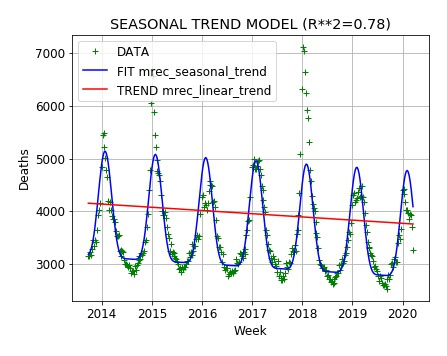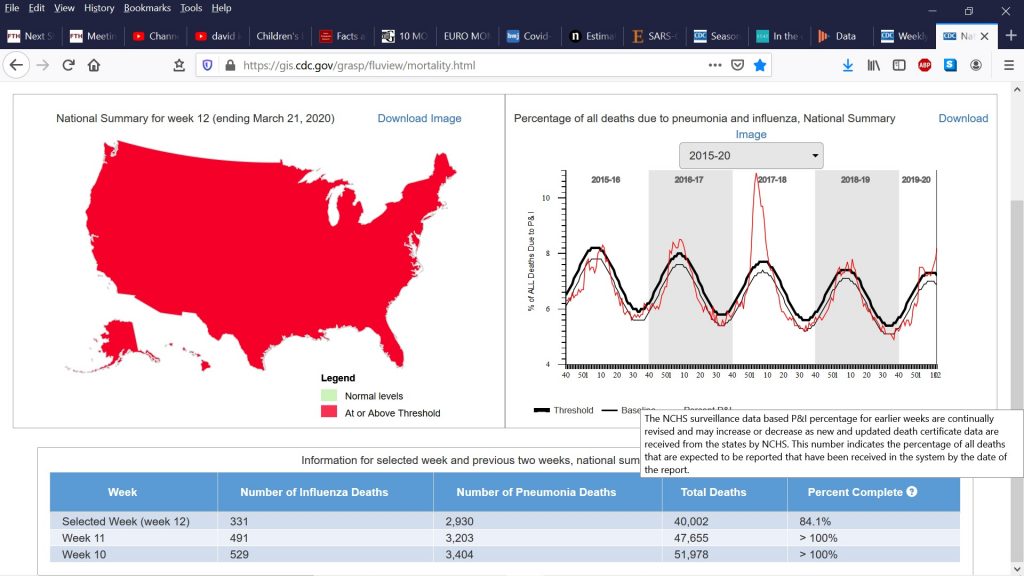A key issue in the current COVID-19 coronavirus pandemic is the role of aerosol transmission which is virtually unstoppable in the spread of the virus. Aerosol transmission is transmission by tiny particles only a few microns in size that float indefinitely or nearly indefinitely in the air. The finest human hair is about twenty microns in diameter.
Asymptomatic carriers which may comprise about eighty percent of cases mostly don’t cough and sneeze which produces larger particles that fall to the ground under gravity. Asymptomatic carriers probably spread the disease primarily through aerosol transmission or physical contact.
Aerosol transmission is virtually unstoppable except by the equivalent of wearing a space suit. If it is a substantial mode of transmission, lockdowns, quarantines, sheltering in place, most face masks, etc. are not effective and cannot explain low death numbers in regions like Santa Clara County, California where I live. One hundred and twenty-eight (128) reported COVID-19 deaths as of May 10, 2020 in a county of almost two million residents, probably with the closest ties to China of any region in the United States.

If aerosol transmission is a substantial mode of transmission, confining large numbers of people to apartment complexes and buildings is likely to spread the disease efficiently through hallways, lobbies, laundry rooms, other shared spaces, and the ventilation system of the building. Similarly, shopping at the few giant stores such as Walmart and Safeway left open as “essential” is likely to spread the disease efficiently.
Indeed more extensive testing appears to be showing the disease is much wider spread than originally thought/expected which also means that it is much less deadly than original reports and claims. The seeming dramatic spread in the New York City area is easy to understand with substantial aerosol transmission.
Aerosol Transmission of Influenza
Given the general panic and newness of the COVID-19 coronavirus, one should examine what is known about aerosol transmission of other, ostensibly well-studied viruses such as influenza. Remarkably, it remains unclear how much aerosol transmission contributes to the spread of influenza and apparently the subject of some controversy.
Given that the devastating “Spanish” or “swine” flu epidemic in 1918 is usually blamed on an influenza virus (as well as high profile “swine flu” scares in 1976 and 2009) this lack of knowledge is troubling: what have the NIH, CDC, and other agencies been doing with billions of dollars in funding specifically to prevent or contain a deadly influenza pandemic?
Some recent references which indicate that aerosol transmission is probably a major route of transmission for influenza.
Aerosol transmission is an important mode of influenza A virus spread
Benjamin J. Cowling, Dennis K. M. Ip, Vicky J. Fang, Piyarat Suntarattiwong, Sonja J. Olsen, Jens Levy, Timothy M. Uyeki, Gabriel M. Leung, J. S. Malik Peiris, Tawee Chotpitayasunondh, Hiroshi Nishiura & James Mark Simmerman Nature Communications volume 4, Article number: 1935 (2013)
Abstract
Influenza A viruses are believed to spread between humans through contact, large respiratory droplets and small particle droplet nuclei (aerosols), but the relative importance of each of these modes of transmission is unclear. Volunteer studies suggest that infections via aerosol transmission may have a higher risk of febrile illness. Here we apply a mathematical model to data from randomized controlled trials of hand hygiene and surgical face masks in Hong Kong and Bangkok households. In these particular environments, inferences on the relative importance of modes of transmission are facilitated by information on the timing of secondary infections and apparent differences in clinical presentation of secondary infections resulting from aerosol transmission. We find that aerosol transmission accounts for approximately half of all transmission events. This implies that measures to reduce transmission by contact or large droplets may not be sufficient to control influenza A virus transmission in households. (EMPHASIS ADDED)
URL: https://www.ncbi.nlm.nih.gov/pubmed/23736803
Aerosol transmission of influenza A virus: a review of new studies
Raymond Tellier
Abstract
Over the past few years, prompted by pandemic preparedness initiatives, the debate over the modes of transmission of influenza has been rekindled and several reviews have appeared. Arguments supporting an important role for aerosol transmission that were reviewed included prolonged survival of the virus in aerosol suspensions, demonstration of the low infectious dose required for aerosol transmission in human volunteers, and clinical and epidemiological observations were disentanglements of large droplets and aerosol transmission was possible. Since these reviews were published, several new studies have been done and generated new data. These include direct demonstration of the presence of influenza viruses in aerosolized droplets from the tidal breathing of infected persons and in the air of an emergency department; the establishment of the guinea pig model for influenza transmission, where it was shown that aerosol transmission is important and probably modulated by temperature and humidity; the demonstration of some genetic determinants of airborne transmission of influenza viruses as assessed using the ferret model; and mathematical modelling studies that strongly support the aerosol route. These recent results and their implication for infection control of influenza are discussed in this review.
J R Soc Interface. 2009 Dec 6; 6(Suppl 6): S783–S790.
URL: https://www.ncbi.nlm.nih.gov/pmc/articles/PMC2843947/
Review of Aerosol Transmission of Influenza A Virus
Raymond Tellier
In theory, influenza viruses can be transmitted through aerosols, large droplets, or direct contact with secretions (or fomites). These 3 modes are not mutually exclusive. Published findings that support the occurrence of aerosol transmission were reviewed to assess the importance of this mode of transmission. Published evidence indicates that aerosol transmission of influenza can be an important mode of transmission, which has obvious implications for pandemic influenza planning and in particular for recommendations about the use of N95 respirators as part of personal protective equipment.
Emerg Infect Dis. 2006 Nov; 12(11): 1657–1662.
URL: https://www.ncbi.nlm.nih.gov/pmc/articles/PMC3372341/
Aerosol Transmission of the COVID-19 Coronavirus
Much of the published literature on aerosol transmission of SARS-COV-2 focuses on possible aerosol transmission during medical procedures and the risks to doctors, dentists, and other health professionals. This has been part of the justification for aggressive use of intubation in treatment of the disease. Intubation is an extremely risky, dangerous medical procedure.
There have been some scientific and scholarly articles on aerosol transmission in non-medical settings — the general spread of the disease etc. It should be noted that all articles on COVID-19 in the last few months are the product of a high stress crisis atmosphere where the fight-or-flight response is almost certainly activated at a high level. The fight-or-flight response generally degrades much higher cognitive function in favor of short term thinking optimized for physical combat in ancient times.
Airborne transmission of SARS-CoV-2: the world should face the reality
Lidia Morawskaa,⁎ and Junji Caob
Hand washing and maintaining social distance are the main measures recommended by the World Health Organization (WHO) to avoid contracting COVID-19. Unfortunately, these measured do not prevent infection by inhalation of small droplets exhaled by an infected person that can travel distance of meters or tens of meters in the air and carry their viral content. Science explains the mechanisms of such transport and there is evidence that this is a significant route of infection in indoor environments. Despite this, no countries or authorities consider airborne spread of COVID-19 in their regulations to prevent infections transmission indoors. It is therefore extremely important, that the national authorities acknowledge the reality that the virus spreads through air, and recommend that adequate control measures be implemented to prevent further spread of the SARS-CoV-2 virus, in particularly removal of the virus-laden droplets from indoor air by ventilation.
Environ Int. 2020 Apr 10 : 105730.
URL: https://www.ncbi.nlm.nih.gov/pmc/articles/PMC7151430/
Airborne route and bad use of ventilation systems as non-negligible factors in SARS-CoV-2 transmission
G. Correia,a,b,⁎ L. Rodrigues,b M. Gameiro da Silva,c and T. Gonçalvesa,b
Summary
The world is facing a pandemic of unseen proportions caused by a corona virus named SARS-CoV-2 with unprecedent worldwide measures being taken to tackle its contagion. Person-to-person transmission is accepted but WHO only considers aerosol transmission when procedures or support treatments that produce aerosol are performed. Transmission mechanisms are not fully understood and there is evidence for an airborne route to be considered, as the virus remains viable in aerosols for at least 3 h and that mask usage was the best intervention to prevent infection.
Heating, Ventilation and Air Conditioning Systems (HVAC) are used as a primary infection disease control measure. However, if not correctly used, they may contribute to the transmission/spreading of airborne diseases as proposed in the past for SARS.
The authors believe that airborne transmission is possible and that HVAC systems when not adequately used may contribute to the transmission of the virus, as suggested by descriptions from Japan, Germany, and the Diamond Princess Cruise Ship. Previous SARS outbreaks reported at Amoy Gardens, Emergency Rooms and Hotels, also suggested an airborne transmission.
Further studies are warranted to confirm our hypotheses but the assumption of such way of transmission would cause a major shift in measures recommended to prevent infection such as the disseminated use of masks and structural changes to hospital and other facilities with HVAC systems.
Med Hypotheses. 2020 Aug; 141: 109781.
URL: https://www.ncbi.nlm.nih.gov/pmc/articles/PMC7182754/
Consideration of the Aerosol Transmission for COVID‐19 and Public Health
Elizabeth L. Anderson
Paul Turnham
John R. Griffin
Chester C. Clarke
Risk Analysis: An International Journal (First published: 01 May 2020)
Abstract
This article analyzes the available evidence to address airborne, aerosol transmission of the SARS-CoV-2. We review and present three lines of evidence: case reports of transmission for asymptomatic individuals in association with studies that show that normal breathing and talking produce predominantly small droplets of the size that are subject to aerosol transport; limited empirical data that have recorded aerosolized SARS‐CoV‐2 particles that remain suspended in the air for hours and are subject to transport over distances including outside of rooms and intrabuilding, and the broader literature that further supports the importance of aerosol transmission of infectious diseases. The weight of the available evidence warrants immediate attention to address the significance of aerosols and implications for public health protection.
URL: https://onlinelibrary.wiley.com/doi/full/10.1111/risa.13500
Conclusion
There is a remarkable lack of key measurements in the current coronavirus COVID-19 pandemic. These include the actual mortality rate (aka infection fatality rate) broken down by age, sex, race, pre-existing medical conditions, ambient temperature, sunlight levels, pollution levels, other risk factors and medical treatment used (e.g. intubation). The false positive and false negative rates of the tests for the disease, both the tests for an active infection such as the RT-PCR tests and tests for past infection such as the antibody tests. The methods and rates of transmission for the disease. Aerosol transmission probably occurs at least at a low level and is virtually unstoppable.
The CDC and the National Security bioweapons defense programs should have been set up to quickly and efficiently collect these key data and parameters as soon as a possible outbreak or attack was detected, independent of warnings and information provided by a potential adversary such as China or from the World Health Organization (WHO).
These key measurements of the properties of the virus and disease should be collected as soon as possible by anyone who can and shared with the world.
(C) 2020 by John F. McGowan, Ph.D.
About Me
John F. McGowan, Ph.D. solves problems using mathematics and mathematical software, including developing gesture recognition for touch devices, video compression and speech recognition technologies. He has extensive experience developing software in C, C++, MATLAB, Python, Visual Basic and many other programming languages. He has been a Visiting Scholar at HP Labs developing computer vision algorithms and software for mobile devices. He has worked as a contractor at NASA Ames Research Center involved in the research and development of image and video processing algorithms and technology. He has published articles on the origin and evolution of life, the exploration of Mars (anticipating the discovery of methane on Mars), and cheap access to space. He has a Ph.D. in physics from the University of Illinois at Urbana-Champaign and a B.S. in physics from the California Institute of Technology (Caltech).














